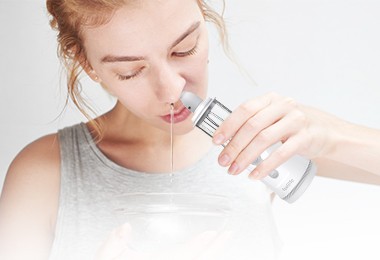Nasal rinsing, also known as nasal irrigation, is a simple yet effective technique for relieving sinus congestion and promoting nasal health. Nasal rinsing is a natural and drug-free method that involves flushing out the nasal passages with a saline solution. It helps to remove excess mucus, allergens, and irritants, thereby reducing congestion and promoting clearer breathing. This step-by-step guide will walk you through the process of nasal rinsing, providing valuable insights and tips for a successful experience.

Step 1: Gather Your Supplies - Ensuring a Smooth Nasal Rinsing Experience
Before you embark on the journey of nasal rinsing, it's essential to gather all the necessary supplies to make the process seamless and effective. The items you will need include a nasal rinse device, such as a neti pot or a nasal saline spray, distilled or sterile water, and a specially formulated saline solution.
Additionally, it's important to note that using tap water for your nasal rinse is not recommended. Tap water may contain impurities, such as bacteria or microorganisms, which can irritate your nasal passages. To avoid such complications, always opt for distilled or sterile water to ensure a clean and safe nasal rinsing experience.
Step 2: Prepare the Saline Solution - Finding the Perfect Balance
If you are using a neti pot, you can prepare the solution by mixing the recommended amount of salt with warm distilled or sterile water. The water should be comfortably warm, but not too hot to cause any discomfort.
If you prefer a hassle-free option, pre-packaged saline solutions are readily available in most pharmacies or drugstores. These solutions come in convenient single-use packets, eliminating the need for measuring and mixing. Simply follow the instructions on the packet to prepare the solution.
Remember, the saline solution should be isotonic, meaning it matches the salt concentration of your body's cells. This ensures that the solution doesn't cause any stinging or burning sensations during the rinse. Maintaining the proper balance of salt to water is crucial for a gentle and effective nasal rinse.
Step 3: Position Yourself Correctly - Finding Comfort in the Right Posture
You have a couple of options based on personal preference and convenience. One common approach is to lean over a sink, while another is to stand in the shower. Whichever position you choose, remember to tilt your head slightly to the side.
When leaning over a sink, it's beneficial to position your head at a 45-degree angle. This angle allows the saline solution to flow smoothly through your nasal passages, effectively flushing out any congestion or debris.
Step 4: Administer the Rinse - A Gentle and Effective Process
Begin by gently inserting the nozzle of your chosen nasal rinse device into one nostril. Ensure a secure seal to prevent any leakage during the process. With the neti pot, you can tilt it slightly to allow gravity to aid the flow of the saline solution.
Once in position, slowly and steadily pour or spray the saline solution into the nostril. As the solution enters your nasal passages, it will effectively wash away mucus, allergens, and irritants that may be causing congestion. Allow the solution to flow through the nasal passages and exit from the other nostril.
During the process, remember to breathe through your mouth to avoid accidentally swallowing the solution. Breathing gently and staying relaxed can help make the experience more comfortable and effective.
Step 5: Repeat for the Other Nostril - Ensuring Balanced Relief
To achieve balanced relief and ensure both nasal passages receive the benefits of the saline solution, it's important to repeat the rinse for the other nostril. Simply switch to the opposite nostril and repeat the process, following the same steps outlined in Step 4.
Step 6: Rinse and Dry the Device - Hygiene and Device Maintenance
Thoroughly rinse the nasal rinse device with distilled or sterile water to remove any residual saline solution or debris. This helps prevent the growth of bacteria or mold, ensuring the device remains clean and safe for future use.
After rinsing, it's essential to dry the device thoroughly. Placing it in an upright position or using a clean towel to absorb excess moisture can help expedite the drying process. Avoid storing the device while it is still wet, as this can create an environment for bacterial growth.Nasal rinsing is a simple and effective method for relieving nasal congestion and promoting sinus health. By following this step-by-step guide, you can incorporate nasal rinsing into your daily routine and experience the benefits of clearer breathing and sinus relief. Remember to use the correct supplies, prepare the saline solution properly, and follow the recommended techniques. With regular nasal rinsing, you can enjoy improved nasal health and a greater sense of well-being.